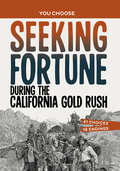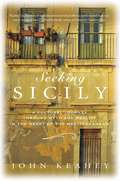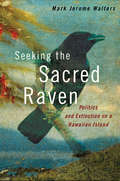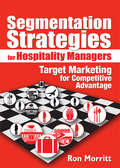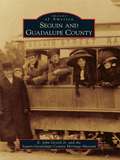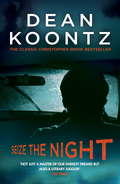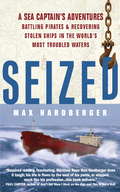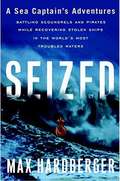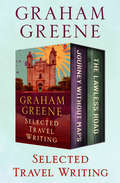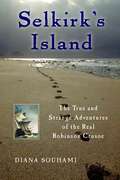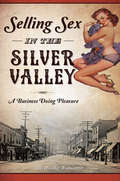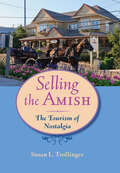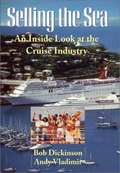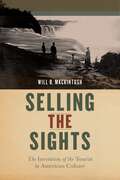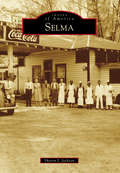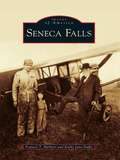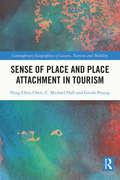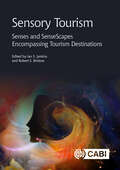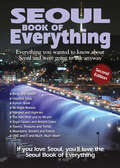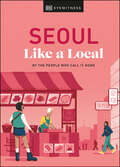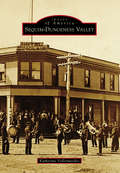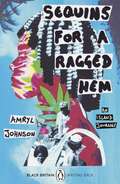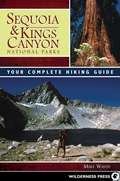- Table View
- List View
Seeking Fortune During the California Gold Rush: A History Seeking Adventure (You Choose: Seeking History)
by Matt DoedenYOU are one of the many fortune seekers during the California Gold Rush in the 1850s. Will you pan for gold, set up a mine, or make your riches by serving the miners who have flocked to the area? Step back in time to face the challenges and decisions that real people faced during this exciting time in history.
Seeking Sicily: A Cultural Journey Through Myth and Reality in the Heart of the Mediterranean
by John KeaheySicily is the Mediterranean's largest and most mysterious island. Its people, for three thousand years under the thumb of one invader after another, hold tightly onto a culture so unique that they remain emotionally and culturally distinct, viewing themselves first as Sicilians, not Italians. Many of these islanders, carrying considerable DNA from Arab and Muslim ancestors who ruled for 250 years and integrated vast numbers of settlers from the continent just ninety miles to the south, say proudly that Sicily is located north of Africa, not south of Italy. Seeking Sicily explores what lies behind the soul of the island's inhabitants. It touches on history, archaeology, food, the Mafia, and politics and looks to nineteenth- and twentieth-century Sicilian authors to plumb the islanders' so-called Sicilitudine. This "culture apart" is best exemplified by the writings of one of Sicily's greatest writers, Leonardo Sciascia. Seeking Sicily also looks to contemporary Sicilians who have never shaken off the influences of their forbearers, who believed in the ancient gods and goddesses.
Seeking the Sacred Raven: Politics and Extinction on a Hawaiian Island
by Mark Jerome WaltersWill the 'Alala ever return to the wild? A bird sacred to Hawaiians and a member of the raven family, the 'Alala today survives only in captivity. How the species once flourished, how it has been driven to near-extinction, and how people struggled to save it, is the gripping story of Seeking the Sacred Raven. For years, author Mark Jerome Walters has tracked the sacred bird's role in Hawaiian culture and the indomitable 'Alala's sad decline. Trekking through Hawaii's rain forests high on Mauna Loa, talking with biologists, landowners, and government officials, he has woven an epic tale of missed opportunities and the best intentions gone awry. A species that once numbered in the thousands is now limited to about 50 captive birds. Seeking the Sacred Raven is as much about people and culture as it is about failed policies. From the ancient Polynesians who first settled the island, to Captain Cook in the 18th century, to would-be saviors of the 'Alala in the 1990s, individuals with conflicting passions and priorities have shaped Hawaii and the fate of this dwindling cloud-forest species. Walters captures brilliantly the internecine politics among private landowners, scientists, environmental groups, individuals and government agencies battling over the bird's habitat and protection. It's only one species, only one bird, but Seeking the Sacred Raven illustrates vividly the many dimensions of species loss, for the human as well as non-human world.
Segmentation Strategies for Hospitality Managers: Target Marketing for Competitive Advantage
by Art Weinstein Ron MorrittGet the competitive edge in a fierce market!Effective market segmentation approaches can show a company which customer group is most profitable and how to best serve their needs. Segmentation Strategies for Hospitality Managers: Target Marketing for Competitive Advantage is a marketing primer whose time has come, teaching segmentation approaches that can make a difference where it really counts-the bottom line. Introductory to intermediate level hospitality managers and students are provided with easy-to-follow explanations and effective learning exercises that will help them grasp segmentation concepts and strategies quickly. Unlike other hospitality marketing textbooks out there, this book persistently focuses specifically on segmentation and positioning strategies.Segmentation Strategies for Hospitality Managers effectively tells how to best use the integrated resources of a hospitality firm to gain and maintain the competitive edge. Examples are taken from the hotel, restaurant, and airline industries to give a well-rounded view of the industry&’s practical and productive use of segmentation strategies. The text explains advantages and limitations of various segmentation strategies such as relationship or niche marketing to help assist managers in their own future decision-making process. Detailed chapter summaries and challenging end-of-chapter exercises further reinforce each chapter&’s concepts and approaches. Extensive references, several illustrative figures and tables, and specific case examples from various hospitality sectors are included.Topics in Segmentation Strategies for Hospitality Managers include: positioning strategy niche marketing relationship marketing marketing trends technology&’s impact on the hospitality industryspecial issues in segmentation strategy (including integration of segmentation strategy with branding, yield management, and IT strategy) and more!Segmentation Strategies for Hospitality Managers is a resource certain to be used again and again and is perfect for hospitality managers, marketing and hospitality educators, hospitality and travel and tourism students, and business school students world wide.
Seguin and Guadalupe County
by Seguin-Guadalupe County Heritage Museum E. John Gesick Jr.Originally named Walnut Springs in 1838, Seguin was renamed one year later after Mexican Texas Revolution hero Juan N. Seguin, who fought at the Alamo and the Battle of San Jacinto. The town of Seguin and the surrounding area have always been a crossroads for commerce--from the southeast Gulf Coast region throughout the rest of the state. Seguin's Texas Rangers initially provided security for frontier settlers, and many of the area's residents served in the U.S. military. From Austin to the U.S. Congress, Seguin's citizens have also served their country as representatives, state senators, and as governor. In the 21st century, Seguin continues to redefine itself as a leading business and manufacturing community while still retaining its agricultural roots. Seguin and Guadalupe County's achievements in education have been recognized at the national level for Texas Lutheran University, and by the state for its public school system. Longtime residents of Seguin and Guadalupe County remember their heritage with pride as they welcome newcomers to the area.
Seis Contos Do Exterior
by Bruno Maiorana and 5 moreEste livro é uma compilação de interessantes histórias que documentam as idas e vindas da vida como estrangeiro, expatriado, imigrante, ou qualquer outro termo que você prefira para descrever a vida em um lugar diferente daquele onde se cresceu. As histórias são do Peru, China, Equador e Espanha;
Seismic Assessment, Behavior and Retrofit of Heritage Buildings and Monuments
by Manolis Papadrakakis Ioannis N. Psycharis Stavroula J. PantazopoulouThis book assembles, identifies and highlights the most recent developments in Rehabilitation and retrofitting of historical and heritage structures. This is an issue of paramount importance in countries with great built cultural heritage that also suffer from high seismicity, such as the countries of the eastern Mediterranean basin. Heritage structures range from traditional residential constructions to monumental structures, ancient temples, towers, castles, etc. It is generally recognized that these structures present particular difficulties in seismic response calculation through computer simulation due to the complexity of the structural system which is, generally, inhomogeneous, with several contact problems, gaps/joints, nonlinearities and brittleness in material constituents. This book contains selected papers from the ECCOMAS Thematic Conferences on Computational Methods in Structural Dynamics & Earthquake Engineering (COMPDYN) that were held in Corfu, Greece in 2011 and Kos, Greece in 2013. The Conferences brought together the scientific communities of Computational Mechanics, Structural Dynamics and Earthquake Engineering in an effort to facilitate the exchange of ideas in topics of mutual interest and to serve as a platform for establishing links between research groups with complementary activities.
Seize the Night: An unputdownable thriller of suspense and danger (Moonlight Bay Trilogy)
by Dean KoontzChildren are disappearing one by one... Seize the Night is the brilliant second thriller in Dean Koontz's Moonlight Bay trilogy, following the acclaimed bestseller Fear Nothing. Perfect for fans of Richard Laymon and Harlan Coben. 'Dean Koontz has always boldly gone where no other fiction writer has even considered going before. As ever, the writing is fluid, the dynamic taunt and the relationships between the characters compulsive' - The Times One by one, the children of Moonlight Bay are disappearing. No one knows if they are dead or alive.Christopher Snow, suffering from the rare disorder xeroderma pigmentosum, has glimpsed the dark and torrid secrets of the small-town community where he has spent his entire life. And only he has the key to the truth - a truth that could only exist in the genetic chaos of Moonlight Bay. What readers are saying about Seize the Night: 'Koontz has a way of reaching out to you and dragging you into your weirdest and wildest dreams and nightmares, making them a reality''Koontz's character build-up is so real, so seemingly effortless, that you just take his characters for granted as your own friends''A shockingly strange novel yet it was made real by the artistic and imaginative writing of Dean Koontz'
Seized!: A Sea Captain's Adventures Battling Pirates and Recovering Stolen Ships in the World's Most Troubled Waters
by Max HardbergerCapt. Max Hardberger uses every trick, tool and tactic at his disposal to right wrongs and out-pirate pirates in this action-packed exposé of the seedy underworld of international shipping. As a professional ship extractor, he risks death and imprisonment in dangerous third-world ports to steal ships from modern buccaneers and corrupt governments and deliver them back to their rightful owners. In the course of his adventures, he's had to outwit resourceful crime families, subdue armed soldiers, and turn the tables on clever con artists. He's escaped imprisonment in Venezuela and avoided death at the hands of the Russian mafia. Because Max shuns the use of force, the ingenious methods he must use to accomplish his missions are the stuff of legend he's employed a witch doctor in Haiti, tricked armed guards off a ship in Honduras, and rented a brothel in Mexico, all to thwart the designs of ship-thieves. Seized! is an intense, fast-paced window on the underbelly of ocean shipping, where all power comes from the barrel of a gun, and the only law is the law of survival.
Seized: A Sea Captain’s Adventures Battling Scoundrels and Pirates While Recovering Stolen Ships in the World’s Most Troubled Waters
by Max HardbergerSeizedthrows open the hatch on the shadowy world of maritime shipping, where third-world governments place exorbitant liens against ships, pirates seize commercial vessels with impunity, crooks and con artists reign supreme on the docks and in the shipyards-and hapless owners have to rely on sea captain Max Hardberger to recapture their ships and win justice on the high seas. A ship captain, airplane pilot, lawyer, teacher, writer, adventurer, and raconteur, Max Hardberger recovers stolen freighters for a living. InSeized, he takes us on a real-life journey into the mysterious world of freighters and shipping, where fortunes are made and lost by the whims of the waves. Desperate owners hire Max Hardberger to "extract" or steal back ships that have been illegitimately seized by putting together a mission-impossible team to sail them into international waters under cover of darkness. It's a high stakes assignment-if Max or his crew are caught, they risk imprisonment or death. Seizedtakes readers behind the scenes of the multibillion dollar maritime industry, as he recounts his efforts to retrieve freighters and other vessels from New Orleans to the Caribbean, from East Germany to Vladivostak, Russia, and from Greece to Guatemala. He resorts to everything from disco dancing to women of the night to distract the shipyard guards, from bribes to voodoo doctors to divert attention and buy the time he needs to sail a ship out of a foreign port without clearance. Seizedis adventure nonfiction at its best.
Selected Travel Writing: Journey Without Maps and The Lawless Roads
by Graham GreeneA pair of revelatory travel memoirs from &“a superb storyteller . . . [who] had a talent for depicting local color&” (The New York Times). &“One of the finest writers of any language,&” British author Graham Greene embarked on two awe-inspiring and eye-opening journeys in the 1930s—to West Africa and to Mexico (The Washington Post). Greene would find himself both shaken and inspired by these trips, which would go on to inform his novels. Journey Without Maps: When Graham Greene set off from Liverpool in 1935 for what was then an Africa unmarked by colonization, it was to leave the known transgressions of his own civilization behind for those unknown. First by cargo ship, then by train and truck through Sierra Leone, and finally on foot, Greene embarked on a dangerous and unpredictable 350-mile, four-week trek through Liberia with his cousin and a handful of servants and bearers into a world where few had ever seen a white man. For Greene, this odyssey became as much a trip into the primitive interiors of the writer himself as it was a physical journey into a land foreign to his experience. &“One of the best travel books [of the twentieth] century.&” —The Independent The Lawless Roads: This eyewitness account of religious and political persecution in 1930s Mexico inspired The Power and the Glory, the British novelist&’s &“masterpiece&” (John Updike). In 1938, Greene, a burgeoning convert to Roman Catholicism, was commissioned to expose the anticlerical purges in Mexico. Churches had been destroyed, peasants held secret masses in their homes, religious icons were banned, and priests disappeared. Traveling under the growing clouds of fascism, Greene was anxious to see for himself the effect it had on the people. Journeying through the rugged and remote terrain of Chiapas and Tabasco, Greene&’s emotional, gut response to the landscape; the sights and sounds; the oppressive heat; and the people&’s fear, despair, resignation, and fierce resilience makes for a vivid and powerful chronicle. &“[A] singularly beautiful travel book.&” —New Statesman
Selkirk's Island
by Diana SouhamiBiographer Diana Souhami tells the story of Alexander Selkirk (1680- 1721), marooned on a remote island west of South America in the early 18th century; his experiences inspired Defoe's novel, Robinson Crusoe. Souhami draws from several resources, including accounts by Selkirk, his rescuers, fellow crewmen, and eighteenth century writers, petitions by two women each claiming to be Selkirk's wife, and historical maritime documents. She combines these with her own experiences of living for three months on the island to give the reader a sense of who Selkirk was, and what he really experienced during his four, solitary years on the desert island. Illustrated with black-and-white maps, charts, and photographs, this academic work is accessible to the general reader. Annotation c. Book News, Inc., Portland, OR (booknews.com)
Selling Sex in the Silver Valley: A Business Doing Pleasure
by Dr Heather BranstetterOnce the largest silver producer in the world, Wallace became notorious for labor uprisings, hard drinking, gambling and prostitution. As late as 1991, illegal brothels openly flourished because locals believed that sex work prevented rape and bolstered the economy, so long as it was regulated and confined to a particular area of town. The madams enjoyed unprecedented status as influential businesswomen, community leaders and philanthropists, while elsewhere a growing aversion to the sex trade drove red-light districts underground. Dr. Heather Branstetter’s research features previously unpublished archival materials and oral histories as she relates the intimate details of this unlikely story.
Selling the Amish: The Tourism of Nostalgia (Young Center Books in Anabaptist and Pietist Studies)
by Susan L. TrollingerMore than 19 million tourists flock to Amish Country each year, drawn by the opportunity to glimpse "a better time" and the quaint beauty of picturesque farmland and handcrafted quilts. What they may find, however, are elaborately themed town centers, outlet malls, or even a water park. Susan L. Trollinger explores this puzzling incongruity, showing that Amish tourism is anything but plain and simple.Selling the Amish takes readers on a virtual tour of three such tourist destinations in Ohio’s Amish Country, the world’s largest Amish settlement. Trollinger examines the visual rhetoric of these uniquely themed places—their architecture, interior decor, even their merchandise and souvenirs—and explains how these features create a setting and a story that brings tourists back year after year.This compelling story is, Trollinger argues, in part legitimized by the Amish themselves. To Americans faced with anxieties about modern life, being near the Amish way of life is comforting. The Amish seem to have escaped the rush of contemporary life, the confusion of gender relations, and the loss of ethnic heritage. While the Amish way supports the idealized experience of these tourist destinations, it also raises powerful questions. Tourists may want a life uncomplicated by technology, but would they be willing to drive around in horse-drawn buggies in order to achieve it?Trollinger's answers to important questions in her fascinating study of Amish Country tourism are sure to challenge readers’ understanding of this surprising cultural phenomenon.
Selling the Sea: An Inside Look at the Cruise Industry
by Bob Dickinson Andy VladimirAn insider's view of how the cruising business operates. "Selling the Sea" offers a complete picture of the cruise line industry along with step-by-step coverage of how to effectively market the cruising experience. This updated "Second Edition" features new coverage of how technology has impacted the industry, new niche markets in cruising, and expanded material on shipbuilding and design. It also includes insightful interviews with today's captains, social directors, food and beverage managers, and cruise line executives who have hands-on experience at the day-to-day workings of a cruise ship. Bob Dickinson is President and CEO of Carnival Cruise Lines and a member of the Board of Directors of the parent company Carnival Corporation. Andy Vladimir is a well-known business and travel writer, a member of the Editorial Board of the FIU Hospitality Review, and contributing editor of Quest magazine.
Selling the Sights: The Invention of the Tourist in American Culture (Early American Places #16)
by Will B. MackintoshA fascinating journey through the origins of American tourismIn the early nineteenth century, thanks to a booming transportation industry, Americans began to journey away from home simply for the sake of traveling, giving rise to a new cultural phenomenon —the tourist.In Selling the Sights, Will B. Mackintosh describes the origins and cultural significance of this new type of traveler and the moment in time when the emerging American market economy began to reshape the availability of geographical knowledge, the material conditions of travel, and the variety of destinations that sought to profit from visitors with money to spend. Entrepreneurs began to transform the critical steps of travel—deciding where to go and how to get there—into commodities that could be produced in volume and sold to a marketplace of consumers. The identities of Americans prosperous enough to afford such commodities were fundamentally changed as they came to define themselves through the consumption of experiences.Mackintosh ultimately demonstrates that the cultural values and market forces surrounding tourism in the early nineteenth century continue to shape our experience of travel to this day.
Selma (Images of America)
by Sharon J. JacksonOn April 2, 1865, one of the last battles of the Civil War destroyed nearly three-fourths of Selma and effected tremendous change in the lives of its people. At the war's beginning, Selma became a transportation center and one of the main manufacturing centers supporting the South's war effort. Its foundries produced much-needed supplies and munitions, and its naval yard constructed Confederate warships. A century later, Selma again became the scene of a dramatic struggle when it served as the focal point of the voting-rights movement. On Sunday, March 7, 1965, approximately 600 marchers set out from Brown Chapel A.M.E. Church on US Highway 80, headed for Montgomery to petition the state legislature for reforms in the voter-registration process. They were met six blocks outside of town at the Edmund Pettus Bridge by state and local law enforcement and were turned back with Billy clubs and tear gas--the day became known as "Bloody Sunday." On March 25, after much discussion and a court injunction, some 25,000 marchers finally crossed the Edmund Pettus Bridge on their way to Montgomery.
Seneca Falls
by Kathy Jans-Duffy Frances T. BarbieriA village located along the Seneca River, Seneca Falls was incorporated in 1831 and was soon linked to the Erie Canal by the Cayuga Seneca Canal. The women's suffrage movement was born in Seneca Falls when the first Women's Rights Convention, led by Elizabeth Cady Stanton, was held on July 19 and 20, 1848. Seneca County and Seneca Falls were also part of the Underground Railroad, and prominent citizens such as Ansel Bascom and Henry Seymour worked with freedom seekers in the decades before the Civil War. The town's knitting mills produced socks for the army during the war, second only to New York City in production. Many famous people also came to Seneca Falls to rally around the town's causes, among them are Lucretia Mott, Frederick Douglass, Garrett Smith, and Susan B. Anthony.
Sense of Place and Place Attachment in Tourism (Contemporary Geographies of Leisure, Tourism and Mobility)
by C. Michael Hall Girish Prayag Ning Chris ChenPlace is integral to tourism. In tourism, almost all issues can ultimately be traced back to human–place interactions and human–place relationships. Sense of place, also referred to as place attachment, topophilia, and community sentiment, has received significant attention in tourism studies because it both contributes to, and is affected by, tourism. This book, written by notable authors in the field, examines sense of place and place attachment in terms of a typology of sense of place/place attachment that includes genealogical/historical, narrative/cultural, economic, ideological, cosmological, and dynamic elements. Dimensions of place attachment such as place identity, place dependence, and affective attachment are discussed as well as place marketing, place making, and destination management. Complete with a range of illustrative international cases and examples ranging from Santa Claus to the importance of place in indigenous and traditional cultures, this book represents a substantial addition to knowledge on the inseparable relationship between tourism and place and will be of great interest to all upper-level students and researchers of Tourism.
Sensory Tourism: Senses and SenseScapes Encompassing Tourism Destinations
by Carlos Ferreira Karen Davies Rubén C. Lois-González Gunnar Thór Jóhannesson Professor Katrín Anna Lund Carla Fraga Elisa Alén González Philip Stone Tim Taylor Trinidad Domínguez Vila Kathryn Terzano Émilie Crossley Hilary Becker Sara Duerte Prof. Dr. Hairul Nizam Ismail Sofie Scheen Jahnsen Claudette John Margaret Kenna Jaciel Gustavo Kunz Sharanya M Chandru M C Dr Velvet Nelson Dr Nur Haizum Rahman Breixo Martins Rodal Carlos Alberto Romarís Lucia Rubio Bidisha Sarkar Dr Deborah Slater Patricia A. Stokowski Dr Pola Wang Dr Aristeidis Gkoumas Dr Nur Hidayah RahmanTourism offers countless global locations, providing a multitude of sensory experiences. These include commercialised tourism products such as saunas and floatation tanks through to natural phenomenon such as mountains and wilderness destinations. Consequently, sensory elements are a curious concept within tourism because every destination provides a sensory experience of one kind or another. The first of its kind, this book examines holidays and tourism through sensory perceptions which either encourage or deter consumers. It studies sensoryscapes and how they effect and affect tourism at destinations and be linked with the development of tourist niches, reflecting the segmenting of the mass market tourism into smaller segments. Finally, it reflects on how with increased urbanisation there a growing need is to find quiet spaces, free from urban or anthropogenic noise, such as silent retreats and dark sky meditation holidays. Escape has always been one of the main components of tourism development together with attraction to spatial locations that match tourists' needs. Structed to address each of the senses separately, this book provides a: · wide range of case studies from interdisciplinary backgrounds · links amongst common themes across the various threads of research on sensory experiences · theoretical framework and practical application for sensory tourism. It will be of interest to those studying tourism management as well as wider social science disciplines.
Seoul Book of Everything: Everything You Wanted to Know About Seoul and Were Going to Ask Anyway (Book Of Everything Ser.)
by Tim LehnertYour key to the South Korean city&’s neighborhoods, green spaces, and urban design, as well as its history, museums, pop culture, shopping, and more. From ancient royal palaces and Korean traditional houses to all-night markets, N Seoul Tower, and the club scene, no city combines the ancient and the contemporary quite like Seoul. Local experts weigh in on one of the world&’s most dynamic cities, including contributions from Robert Neff, Tracey Stark, Daniel Gray, Kim Young-sook, Joel Levin, Michael J. Meyers, and Mary Crowe. A comedian details the five things you must bring to Korea, a food writer picks five favorite restaurants, and a prominent meteorologist provides the low-down on Seoul&’s climate. You&’ll also find insider takes on local mountains and ghosts, as well as movies, tea houses, night spots, the economy, cultural treasures, essential reads, Buddhist shrines, and Seoul&’s amazing postwar evolution. From the DMZ, the Han River, and Cheonggyecheon Stream to navigating local dining, linguistics, and cultural practices, this completely updated reference will become your go-to book on the &“Land of the Morning Calm.&”
Seoul Like a Local: By the People Who Call It Home (Local Travel Guide)
by Allison Needels Beth Eunhee Hong Arian Khameneh Charles UsherKeen to explore a different side of Seoul? Like a Local is the book for you.This isn&’t your ordinary travel guide. You won&’t find N Seoul Tower or K-Star Road in these pages, because that&’s not where Seoulites hang out. Instead, you&’ll meet the locals at raucous barbecue joints, forward-thinking galleries and underground music dens – and that&’s where this book takes you.Turn the pages to discover:- The small businesses and community strongholds that add character to this vibrant city, recommended by true locals.- 6 themed walking tours dedicated to specific experiences such as flea markets and movie theatres.- A beautiful gift book for anyone seeking to explore Seoul. - Helpful &‘what3word&’ addresses, so you can pinpoint all the listed sights.Compiled by four proud Seoulites, this stylish travel guide is packed with Seoul&’s best experiences and hidden spots, handily categorized to suit your mood and needs.Whether you&’re a restless on the hunt for a new hangout, or a visitor keen to discover a side you won&’t find in traditional guidebooks, Seoul Like A Local will give you all the inspiration you need. About Like A Local:These giftable and collectable guides from DK Eyewitness are compiled exclusively by locals. Whether they&’re born-and-bred or moved to study and never looked back, our experts shine a light on what it means to be a local: pride for their city, community spirit and local expertise. Like a Local Seoul will inspire readers to celebrate the secret as well as the iconic – just like the locals who call the city home. Looking for another guide to Seoul? Explore further with our DK Eyewitness or Top 10 guides to Seoul.
Sequim-Dungeness Valley
by Katherine VollenweiderMastodons roamed the plains of Sequim and Dungeness in the years following the recession of the Cordilleran ice sheets. Millennia later, the villages of S'Klallam were home to those who saw settlers disembarking on the periphery of coastal wilderness. Ancient stands of spruce, cedar, and fir fell in the 1800s, clearing the land for agriculture. By the 1900s, the region exported wheat, potatoes, hay, and oats and became prime dairy land. This compilation of historic photographs illustrates the area's history from the 1800s to 1930 and is complimented by information from archival documents sequestered in historical collections throughout the Puget Sound and at the Museum and Arts Archive in Sequim.
Sequins for a Ragged Hem (Black Britain: Writing Back #8)
by Amryl JohnsonA beautifully atmospheric memoir and travelogue from poet Amryl Johnson depicting her journey from the UK to Trinidad in the 1980s'Memories demanded that I complete this book. If what I experienced was, in fact, a haunting, I believe I have now laid these ghosts to rest in a style which I hope will satisfy even the most determined ones.'Amryl Johnson came to England from Trinidad when she was eleven. As an adult in 1983, ready for a homecoming, she embarks on a journey through the Caribbean searching for home, searching for herself.Landing in Trinidad as carnival begins, she instantly surrenders to the collective, pulsating rhythm of the crowd, euphoric in her total freedom. This elation is shattered when she finds the house where she was born has been destroyed. She cannot escape - nor wants to - from the inheritance of colonialism.Her bittersweet welcome sets the tone for her intoxicating exploration of these distinct islands. In evocative, lyrical prose Sequins for a Ragged Hem is an astonishingly unique memoir, interrogating the way our past and present selves live alongside one another.Selected by Booker Prize-winning author Bernardine Evaristo, this series rediscovers and celebrates pioneering books from Black Britain and the diaspora, which remap the nation and reframe our history.
Sequoia and Kings Canyon National Parks
by Mike WhiteThe southern High Sierra, including Sequoia and Kings Canyon National Parks and the surrounding John Muir, Jennie Lakes, and Monarch Wildernesses, is one of the most magnificent natural areas in the world. Blessed with the largest trees on earth (giant sequoias), one of the deepest canyons in North America (Kings Canyon), and the highest mountain in the continental U.S. (Mt. Whitney), the greater Sequoia-Kings Canyon region offers unparalleled mountain majesty. Along with such superlatives, hundreds of miles of trail provides access to a boundless number of high mountain lakes, wildflower-covered meadows, cascading streams, deep forests, and craggy peaks. Mike White's guide is the only comprehensive guide to this portion of John Muir's Range of Light.
